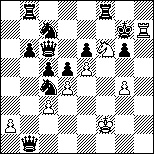 Arvid Sundin v Erik Andersson See my article on the 1985 Swedish stamp in the section on Chess on Stamps.
Arvid Sundin v Erik Andersson See my article on the 1985 Swedish stamp in the section on Chess on Stamps.
For past months, please check out the Chess Blog archive.
Topolov won at the Bali Stars. Here's the final crosstable and here are the games in the final rounds.
The National Chess Congress has finished day two of three. Here are some of the latest games.
For many years, over-the-board players thumbed their noses at those who played correspondence chess. That's changed quite a bit. Correspondence players have added much to theory, and most players now recognize the quality of such games. Wonderful literature on correspondence chess has also helped. From 1990-1995, S1 Editrice published 15 volumes of the Correspndence Chess Yearbook. From 1992 to 1997, there were 9 volumes of the Correspondence Chess Informator. Thinkers Press has republished the wonderful books assembled by Cecil Purdy, including How Purdy Won, the account of his victory in the First World Correspondence Chess Championship.
Other Correspondence Chess World Champions have also placed their mark on recent literature. Hans Berliner, the winner of the 5th Wold title, published a controverial tome, The System. And one of my personal favorites, Grigory Sanakoev's World Champion at the Third Attempt, an account of his victory in the 12th World Championship.
These are only a few of the key books in my correspondence chess bookcase. It was full up, and I'll now have to find more room somewhere for two additional volumes, both from Tim Harding.
Most of you should know Tim Harding as a strong over-the-board author of many opening tomes, including my favorite on the Bishops' Opening. Tim has turned his attention to correspondence chess in recent years, and his Chess Mail web site and publication are must-reads.
For those of us who can't get enough of his fine work, there is Startling Correspondence Chess Miniatures (2000), a wonderful collection of 100 "short" correspondence games (one would think that would be an oxymoron). It's a lively and enjoyable volume, fuill of careful annotations and many surprises. Here's one example:
1.e4 e5 2.Nf3 f5 3.Bc4 b5 4.Bb3 fxe4 5.d4 d5 [5...exf3 6.Qxf3+-] 6.Nxe5 Nf6 7.0-0 c6 8.Nc3 Bd6 9.Bg5 Be7 10.f3 exf3 11.Qxf3 Qb6 12.Bxf6 Bxf6 13.Qe3 Kf8 14.Rae1 Qd8 15.Rxf6+ [15.Nxc6 Nxc6 16.Rxf6+ gxf6 (16...Qxf6 17.Qe8#) 17.Qh6+ Kf7 18.Bxd5++-] 15...Qxf6 [15...gxf6 16.Qh6+ Ke8 17.Qh5+ Ke7 18.Nxc6++-] 16.Nxd5 cxd5 17.Ng6+! 1-0
And there is Harding's latest 2002 book, 64 Great Chess Games: Masterpieces of Postal and Email Chess. This is a real keeper, not just for the careful, fantastically interesting annotations, but as much for having at hand Harding's selections of these games. Two of my personal favorites are there back to back. Game 24 is Arvid Sundler v Erik Andersson, the so-called immortal correspondence game who finish inspired a Swedish stamp!
 Arvid Sundin v Erik Andersson See my article on the 1985 Swedish stamp in the section on Chess on Stamps.
Arvid Sundin v Erik Andersson See my article on the 1985 Swedish stamp in the section on Chess on Stamps.
The other, also contained on this web site, is the great contest between Estrin and Hans Berliner in the 5th World Correspondence Chess championship. That game is also in my Chess on Stamp exhibit because some of Dr. Berliner's postcards are shown there. Dr. Berliner published a famous numbered pamphlet on the Fritz variation on the Two Knight's Defense. Harding summarizes and expands upon that analysis with much candor and clarity.
In short, I wholeheartedly recommend his website and his recent publications. Let it be known far and wide that correspondence chess is alive and well!
I had a wonderful time at the National Chess Congress today. Nice conversations (hey Jason and Andy). Two of my students won their first round games and were hanging in their tougher second round pairings. And I got to watch some of the key first round games. Be sure to check out Michael Rohde's win!
Topolov continues to lead at the Bali International, just 1/2 point ahead of Anand. Here are the games from rounds 5-8.
I showed off my game against Cruzado Duenas in the skittles room in Philly. After my novelty 17.h5, why can't Black just take with 17...Nxh5. The answer is that the Black knight is needed on f4 to help prevent c2-c4. After 17...Nxh5 18.c4! because 18...Qc7 19.cxd5 cxd5 20.Rxd5 Nf4 21.Rd2 f5 22.Bc4+ Kh8 23.Ng5 h6 24.b4 +-
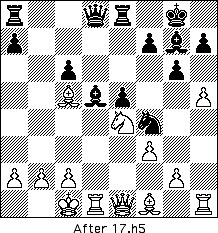
And, of course, I bought some books (like my chess library's not big enough). Check back soon for a review of Tim Harding's 64 Great Chess Games: Masterpieces of Postal and Email chess.
I'll be visiting the National Chess Congress today in Philadelphia. You'll find me at the chess book store at the Adams Mark Hotel in the afternoon and early evening.
The major international chess event this week is the Bali International in Benidorm, Spain. There's some great chess (Topalov and Anand are first and second after 4 rounds), but the big story is that Karpov (whose plane arrived late from Brazil and who requested a postponement of his first round game) was forfeited and later disqualified from the tournament. Here are the games from rounds 1-4.
There's no good transition from that news. Here is one of my recent correspondence wins in a prestigious grandmaster event. My 17th move is a nice novelty, but it's my 21st move that deserves a look. Here's the position with white to move after 19...Qa5. Don't peak!
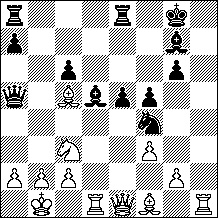
1.e4 c5 2.Nf3 d6 3.d4 cxd4 4.Nxd4 Nf6 5.Nc3 g6 6.Be3 Bg7 7.f3 0-0 8.Qd2 Nc6 9.0-0-0 d5 10.exd5 Nxd5 11.Nxc6 bxc6 12.Bd4 e5 13.Bc5 Be6 14.Ne4 Re8 15.h4 Nf4 16.Qe1 Bd5 17.h5 N [17.c4? Qc7 18.cxd5 cxd5-/+] 17...f5 18.hxg6 hxg6 [18...fxe4 19.fxe4] 19.Nc3 Qa5 20.Nxd5! Qxe1 The threat is Bc4 +- 21.Nxf4!! Qxf1 [21...exf4 22.Bc4+ Qe6 23.Bxe6+ Rxe6 24.Rhe1+/-; 21...Qxd1+ 22.Kxd1 Rad8+ 23.Kc1 exf4 24.Bc4+ Rd5 25.Bxa7+-] 22.Rhxf1 Bh6 23.g3 exf4 24.Rh1 Bg5 25.g4 fxg4 26.Rd6 Be7 27.Rxg6+ Kf7 28.Rxc6 gxf3 29.Bxe7 Rxe7 30.Rc4 Re2 31.Rf1 Rh8 32.b3+- Rhh2 33.Rxf3 Ke6 34.Rfxf4 Rh7 35.Rfe4+ Rxe4 36.Rxe4+ Kd5 37.Rc4 Kd6 38.Kb2 Re7 39.Ka3 1-0
Happy Thanksgiving!
Thinking about the 1960s and 1970s brought back to memory a fun story. It was 1972, one of my early successes. I was 3 1/2 out of 4 in the Central New Jersey Reserve section. Going into the last round, I needed only a draw to clinch a tie for first with my fifth round opponent, Steve Brudno. Steve was well known as a fine player with considerable book knowledge. He was due for white, and always opened with 1.d4. And here I was, a natural player with much less experience and much, much less book knowledge. Not knowing that it would matter, before the tournament I prepared the so-called "Englund Gambit" against 1.d4.
Those of you who know it are aware that the Englund Gambit (1.d4 e5?!) is unsound, despite the following fun trap:
1.d4 e5 The Englund Gambit, a very bad opening popularized by Henry Grob (of 1.g4 fame) 2.dxe5 Nc6 One attack 3.Nf3 One defense 3...Qe7 Awkwardly developing the queen early, but two attacks 4.Bf4 Two defenses 4...Qb4+ Here's black trick. This early check attacks the undefended Bf4 and the b2-pawn. 5.Bd2 [5.Qd2?? Qxb2 6.Qc3 Bb4] 5...Qxb2 6.Bc3? Bb4 7.Qd2 Bxc3 8.Qxc3 [8.Nxc3 Qxa1+-+] 8...Qc1# How's that for a quick checkmate! *
Steve opened 1.d4 and I played my reply, 1...e5. "Good grief!" he said out loud. After all, this was an important game, with $200 each on the line, and my reply is just awful! Here's the game:
Steve Brudno and I were both tied for first. I asked him before the game if he'd be interested in a quick draw, sharing $400. He smiled, and declined my offer. 1.d4 Well booked up, Steve hoped for a Queen's Gambit 1...e5 "Good grief" he exclaimed out loud. After all, here we were in a critical game for first place and this opening has an odor! 2.dxe5 Nc6 3.Nf3 Qe7 4.Bf4 Qb4+ 5.Bd2 Qxb2 6.Nc3! Steve knows his openings! 6...Bb4 7.Rb1 Qa3 8.Rb3 Qa5 9.a3 Bxc3 [9...Bxa3 10.Rxa3 Qxa3 11.Nb5+-] 10.Bxc3 Qc5 headed back to e7 atter Kg8-e7-g6 11.e3 a6 12.Be2!? "Good grief!" I exclaimed and I made my move. [12.Bd3!] 12...Nge7 Where upon, Steve immediately offered a draw. I took the kind offer without even asking him to make a move.
It's a fun story, but I hope that you don't take up the Englund Gambit. There are much better responses out there to 1.d4. Still, here are some other games in the Englund Gambit. You will note that an awful lot of people fell into that funny trap! You will also note that even Keres once tried the Englund Gambit! Like me. I think, he was willing to try anything at least once! I'll still offer up the Englund Gambit against a newcomer in skittles... but only once (smile)
Henri Grob's book on the gambit is well out of print and I lost my copy years ago. A more modern treatment was published in 1988 by Stefan Bucker, but even that now appears to be out of print.
Back in the 1960s and 1970s when I was learning chess, opening books were mostly just collections of "best" lines with endless streams of alternate variations. I spent ages memorizing (not understanding) opening variations with the expected result. Even if I was fortunate to obtain an opening edge, like so many others I had little or no idea how to continue.
Fortunately, today, we have a new approach that emphasizes complete games rather than a series of variations. Readers benefit from seeing how masters convert optimal piece placement and small advantages into the full point.
 I looked today at one such book, Jacob Aagaard's Easy Guide to the Panov-Botvinnik Attack. Don't let the title fool you into thinking that this book is just for beginners. Masters will gain huge insights here too. The focus is on more than games, but on the very themes that permeate all of the variation. Rarely have I seen an author produce such a readable and useful opening text.
I looked today at one such book, Jacob Aagaard's Easy Guide to the Panov-Botvinnik Attack. Don't let the title fool you into thinking that this book is just for beginners. Masters will gain huge insights here too. The focus is on more than games, but on the very themes that permeate all of the variation. Rarely have I seen an author produce such a readable and useful opening text.
Here are a few of the key games analyzed by the author. Enjoy!
With Paul Keres and David Bronstein, Victor Korchnoi certainly belongs on the short list of the greatest players never to become World Champion. He has dwelled near the top of the chess world for about half a century and has challenged all of the recent greats, from Botvinnik and Smyslov and Fischer, Spasky, Petrosian, and Tal through Karpov and Kasparov. Still going strong, he just completed a two game match in Prague against David Navara, the Czech Republic's highest rated player at 2607. Korchnoi lost the match but the games, as usual, are of high quality and of much interest. Here are the games.
In addition to great chess, Korchnoi has recently produced a wonderful two volume set of his best games from 1952-2000. Volume One, his 50 best games with white, won the British Chess Federation's Book of the Year award. Volume Two, of course, are his 50 best games with black.
 Looking for a sleeper of a good book to read for the holidays? Try Vishy Anand's My Best Games of Chess. Anand is the strongest player ever to come from India and was, when the book was written, the second highest rated person in the world. The book contains forty games (and more than 2 dozen tactical exercises from other games)... all carefully explained step-by-step.
Looking for a sleeper of a good book to read for the holidays? Try Vishy Anand's My Best Games of Chess. Anand is the strongest player ever to come from India and was, when the book was written, the second highest rated person in the world. The book contains forty games (and more than 2 dozen tactical exercises from other games)... all carefully explained step-by-step.
Anand lost to Kasparov in the famous match atop the World Trade Center, but we all come out clear winners from his clear writing style and his attacking gems.
There are many ways to learn tactics, but none more fun than playing through the games of tactical magicians like Morphy or Tal. Here's another player to add to that list.
In the early 17th century, an Italian named Gioachhino Greco travelled around Europe earning his living by playing chess (sigh... if only I could do that today!). David Hooper's Oxford Companion to Chess suggests that Greco's games are probably fictitious, but they are nonetheless enjoyable. Greco travelled to Spain in 1624 to defeat all chess competitors at the court of Philip IV. Greco's book: "The Royale Game of Chess-Play" was the game's first classic.
Here's a collection of Greco games.
The computer vs computer World Championship is underway in Graz, Austria. The ChessBase web site is carrying all of the games, and their entry, Fritz, just won a spectacular game in round 2. Here at Queensac, we're especially partial to such queen sacs!
One of my former chess students went to prison yesterday.
Not what you may be thinking. Ian Prevost and three other undergraduates from Princeton University gave a simultaneous chess exhibition at Trenton State prison. The story today in Newsday doesn't mentioned how they did, but I'm proud to have helped Ian to progress very quickly indeed in chess. As memory serves, he twice tied for the scholastic championship in New Jersey, and each time unfairly (I thought) wound up with the second-place trophy. As the story makes clear, these four undergrads are true champions for this kind of public service!
I'll end today with the endgame. Many of you may not yet have mastered the subtleties of Knight + Bishop v King endings. I've never had to prove my mastery of that endgame over-the-board. In the only such correspondence game, my opponent mercifully resigned (after all, I could just look up the correct technique in any endgame book).
You can look it up too, but here's a fun way to get it down... a collection of real over the board games, some featuring some famous grandmasters, in which each had to demonstrate the proper technique. As you will see, not all rose the occasion! It's especially fun to see how the games actually reached these endgames. Enjoy!
On November 5, I talked a bit about the joys of owning a chess database. In my opinion, they are essential for serious correspondence players and those who are serious about improving. The most important feature, I am sure, is the ability simply to play through many games quickly without having to set up the board.
Even more powerful is the possibility of playing through dozens of games in the same opening. Play through 100-200 games in the French Defense and you will have a wealth of experience on which to draw when you next face an opponent in that opening.
The most powerful idea is the database's ability to provide games about various themes. Perhaps you have reached a position with a certain pawn structure. You will be able to view all games that reached that structure!
Or, you can combine the ideas, looking for certain tactical themes or pawn structures in certain openings. Here's a small group of 60 games that have something neat in common. They are all from the Najdorf Sicilian and all involve a knight sacrifice on e6. When does it work, when does it fail? As you see in this collection, it succeeds far more often than not!
One of the pleasures of running a website is seeing who links to you. I've been lucky here. Chess is Fun has been high up on Yahoo and Google searches for "chess" for many years, and many schools and chess clubs link to the site.
We've had links from the tournament sites as well, but the most interesting link by far was from the Fox TV show's website, "24." Here's the link to the Season 1 web page. Click on "Kimberly's Desktop" and then on the chess icon. Lo and behold, you'll be right back to Chess is Fun!
Lot's of fans of the show have sent me mail wondering how or why the link is there. I have no idea, save that I starting getting a lot more traffic when they included the link!
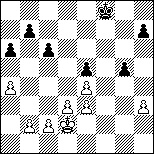 This diagram is from one of my old correspondence games. I played this in a section of the Golden Knights back in 1972! It's lovely king and pawn ending and, of course, it's white to move and win. There's only one way to do it so take some time before you peak at the solution.
This diagram is from one of my old correspondence games. I played this in a section of the Golden Knights back in 1972! It's lovely king and pawn ending and, of course, it's white to move and win. There's only one way to do it so take some time before you peak at the solution.
A relatively quick draw ends the Fritz-Kasparov match, a 2-2 tie. I'm pleased that Kasparov evened the match, and this was not as dull a draw as we have seen before to end these matches. This match will be remembered for those silly black glasses more than the classic human win over the machine in game 3. Kasparov played better, over all, but the awful mistake in round 2 cost him the chance to defeat the machine. All in all, a fun week of chess... and nice to see it on ESPN2.
1.d4 d5 2.c4 dxc4 Queen's Gambit Declined 3.Nf3 e6 4.e3 a6 The idea, of course, is b5. The computer will not want to be down a pawn. 5.Bxc4 c5 6.0-0 Nf6 7.Bb3 cxd4 8.exd4 White has an isolated queen pawn, but that can prove to be dangerous in the hands of the machine. Normally, black would want to blockade the d-pawn with a knight on d5. White will want to play d5 to trade off the pawn. 8...Nc6 9.Nc3 Be7 10.Re1 0-0 11.Bf4 Qd3 and a3 is an alternative 11...Na5 Going after the dangerous Bb3 12.d5 Nxb3 13.Qxb3 Gary takes off his glasses for a long think, reviewing variations in memory. 13...exd5 Fritz has a much more open position than in the last game, and this will be very hard to Gary to win. But Black is in no great danger, and the tactics are easily calculable for him. [ 13...Nxd5 14.Rad1 Nxf4 15.Rxd8 Rxd8] 14.Rad1 pinning rather than capturing the d-pawn. Black needs to defend accurately. 14...Be6 15.Qxb7 No great advantage for white here despite the unbalnced pawn structure. Gary is likely to play Bd6 and Rb8. Black's only danger is the isolated d-pawn. 15...Bd6 16.Bg5 Rb8 17.Qxa6 Rxb2 18.Bxf6 Qxf6 19.Qxd6 Qxc3 very drawish here 20.Nd4 Rxa2 21.Nxe6 fxe6 22.Qxe6+ Kh8 [ 22...Rf7?? 23.Qxd5+-] 23.Rf1 [ 23.Qf7!? Qc8 24.Qxd5 Raxf2] 23...Qc5 Adding a third attack to the white f-pawn. 24.Qxd5 [ 24.Rxd5?? Qxf2+ 25.Rxf2 Ra1+ 26.Rd1 Rxd1+ 27.Qe1 Rxe1+ 28.Rf1 Rfxf1#] 24...Rfxf2 A forced draw. Now Qd8+ Rf8+ or Qxd5?? Rxg2 leads to mate! 25.Rxf2 [ 25.Qd8+ Rf8+ 26.Kh1 Raf2=] 25...Qxf2+ 26.Kh1 h6 [ 26...g6?? 27.Qe5+ Kg8 28.Rd8++-] 27.Qd8+ Kh7 28.Qd3+ [ 28.Qd3+ Kh8 29.Qg6 Qd4=] *
The fourth and final game between Kasparov and Fritz is today at 1pm. The game will be covered on chess.fm, on the Internet Chess Server, and on ESPN2, though the latter seems to move back and forth to other sports du jour.
When Fritz played 5...a6 in game three of the Man v Machine match, Kasparov started a long think. I'm sure that he had expected 5...Nbd7, the move played in game 1. Apart from that, why such a long think?
Only Gary will be able to recreate his thought processes, but I offer some insight into what might have crossed his mind. Here are six games played in the same line. Gary was almost certainly familiar with 2-3 of these games, if not move for move then certainly strategically. He settled upon a clear plan, beginning with c5 and b4, that sealed the board in two. Black gained more space on the kingside, but white had only a single weakness, a well protected pawn on f2.
You will see in these games that the human opponents with black all sought counter-play on the kingside. By contrast, the computer was capable only of generating a single cheapo threat on move 21.
Here are the games. Play through them and you will gain an appreciation, for a moment at least, of what it feels like to be a human grandmaster!
I am sad to report that GM Koneru Humpy was held to a draw in game 12 of the India National Women's ch. That still leaves her with 11.5/12, 1 1/2 ahead of the field. Congratulations to her on this amazing achievement of 11 consecutive wins!
Finally, here are the games of a fun rapid match just completed between Olafsson and Larsen.
A beautiful win for Kasparov in the third round to tie the match with one to play. Fritz varied from Game 1 with 5....a6 (rather than 5...Nbd7). Gary thought for a while, and then settled upon a brilliant strategy against the machine. A long pawn chain, a completely closed position showed that the computer had no idea whatever how to play in such positions.
1.Nf3 Nf6 2.c4 e6 3.Nc3 d5 4.d4 c6 5.e3 a6 6.c5 Nbd7 7.b4 a5 8.b5 e5 9.Qa4 Qc7 10.Ba3 e4 11.Nd2 Be7 12.b6 [12.Be2 h5 13.b6 Qd8 14.h3 Nf8 15.0-0-0 Ne6 16.Ndxe4 Nxe4 17.Nxe4 h4 (17...dxe4 18.d5) 18.Nd2 0-0 19.Rhg1 Re8 20.Bd3 Bf8 21.Bb2 Ng5 22.Qc2 a4 23.a3 Qe7 24.Rde1 Ne4 25.Nf1 Qg5 26.f3 Nf6 27.Kb1 Nh5 28.Bc3 Bd7 29.f4 Qh6 30.Qf2 Qf6 31.Kb2 Bf5 32.Qc2 Be4 33.g4 hxg3 34.Nxg3 Nxg3 35.Rxg3 Bxd3 36.Qxd3 Re4 37.Reg1 Rae8 38.Rf1 Qh4 39.Rfg1 R8e6 40.Qd2 f5 41.Qd3 Qh5 42.Bd2 g6 43.Rg5 Qxh3 44.R1g3 Qh2 45.Rxg6+ Rxg6 46.Rxg6+ Kf7 47.Rg5 Be7 48.Rxf5+ Bf6 49.Kc3 Qh3 50.Rxf6+ Kxf6 51.Qc2 Qf1 52.Qxa4 Qa1+ 53.Kc2 Re8 54.Qb3 Ra8 55.Bc1 Rh8 56.e4 Rh1 57.e5+ Ke7 58.Qe3 Qa2+ 59.Kc3 Rh2 60.Qd3 Qa1+ 61.Kb3 Qxc1 62.f5 Qb2+ 63.Ka4 Rh8 Reshevsky-Keres, 1948] 12...Qd8 13.h3 0-0 14.Nb3 Bd6 15.Rb1 Garry can't 0-0-0 now, and Black will lose the a-pawn. Black must counter-attack on the kingside... will it know that? [15.cxd6 Nxb6-+; 15.Nxa5 Nxb6! 16.cxb6 Bxa3 17.Qxa3 Qxb6-/+; 15.Bb4 Nxb6-/+] 15...Be7 Whoa! A huge loss in time for Fritz! Where's the counter-attack on the kingside? Or is the point of Bd6-e7, white now cannot 0-0-0, and the Be7 may have Bh4 later? Nah... the computer just does not know how to play these closed positions. 16.Nxa5 Now Bb4, Queen back to b3 or c2, and then push the a-pawn. The computer must generate some counter-play with f7-f5-f4 16...Nb8 With what idea? Black has made no progress at all... the pieces ae back on their starting squares. Na6?! is not the right plan... Black needs counter-play on the kingside. Perhaps ...Qd7 and Qf4 17.Bb4 Qd7 18.Rb2 the a1 square is open for king safety... Black needs to play f7-f5-f4, but there's no sign of it. Rb2 assists the kingside defense. White can now consolidate with Qc2 and a3 (or even a4). 18...Qe6 19.Qd1 Nfd7 20.a3 next is Nb3, consolidating the extra pawn. Fritz finally figuring out that f7-f5 is needed for counter-play? 20 moves and Black has barely developed only three pieces. 20...Qh6 The computer begins its attack. Now Qh4, or f5-f4 next. 21.Nb3 Releases the pressure on b7, but frees up the a-pawn to advance. Will Fritz respond with Na6 to stop a4? And can Gary make Nxd5 cxd5 c6 work? 21...Bh4 A simple cheapo threat, Qxe3. White must stop the threat, probably with g3 or possibly Qd2. Gary won't overlook this one! 22.Qd2 Nf6 Very poor! A human knows to get the f-pawn rolling. What is the poor knight to from f6? No need to play g3 now, which would only be needed after f7-f5. 23.Kd1 Moving the king towards the safety of a1-b1 and stopping any possibility of Ng4. Great opening by Gary! The computer is completely lost here! 23...Be6 24.Kc1 When the king gets at a2 (for full safety), white can consider an attack on the kigside with f3! 24...Rd8 no plan at all here. The rook needed to stay on f8 to support f7-f5-f4. These Black moves are not part of a coordinated plan. Now Kb1-a2 or a4-a5. 25.Rc2 Very nice technique. The idea is Kb2 (it's very safe on the dark square and not on a2) and then perhaps Rc1 with the idea of g3 and h4) 25...Nbd7 No need for white to rush, but Na5 looks strong here. But the better plan for white is Kb2 and then a4-5-6, perhaps also with Nxc6 26.Kb2 Nf8 again, no point. How about a4, Gary? Or perhaps Rc1 with the idea of g3 and h4 or Rc1-a1 with support of the a-pawn push 27.a4 On chess.fm, Fedorowicz predicts a5, Na2, Bc3, Nb4 and a6. Looks like a simple, solid plan. 27...Ng6 With what idea? ...Ne5?? 28.a5 Ne7 aimless play by Fritz. Slow plan now with Na2-b4, or a6 straight away with Na5 to follow 29.a6 Black has to capture here with ...bxa6, but Garry gets a protected passed pawn. Then Na5 or Ba5 with the idea of Na2-b4 crushes. 29...bxa6 30.Na5 Rdb8 Now just bring the Nc3 to b4 and the game ends 31.g3 Bg5 32.Bg2 Very cruel play by Gary. Now the Rh1 will join the queenside attack on a1 or b1. The immediate threat is h4 winning the Bg5 32...Qg6 33.Ka1 Taking the K off the b-file, avoiding sacs on b6 and the idea of Ne8-c7 33...Kh8 34.Na2 Kh8 is more of the same. Na2 will go to b4 after Bc3 or Ba3. Gary can also play Rh1-b1 and the Bg2-f1. It's over folks! 34...Bd7 Fritz sees the Na2-b4 after c3 and is trying to over-protect the c6-pawn. 35.Bc3 and after Nb4, Ra2! puts more pressure on the a6-pawn. 35...Ne8 no idea here either... no sacs in the air (Nd6?). Nb4 coming. 36.Nb4 Ra2, Bf1, Qe2 are all in the air. A human might resign here. How about Ctrl-Alt-Del? 36...Kg8 Harumph. Another meaningless move by Fritzy. 37.Rb1 Bc8 38.Ra2 Bh6 39.Bf1 Now Rb3-a3, or Qe2, or Nb3 and Ra5 39...Qe6 with the defensive idea of Bb7 and Qd7 40.Qd1 with ten seconds to go before the time control 40...Nf6 41.Qa4 Bb7 42.Nxb7 Rxb7 43.Nxa6 and now Qa4-c2 and Nc7. A GM would resign here... 43...Qd7 Qc2, with the idea of Rb3-a3 44.Qc2 Kh8 45.Rb3 Certainly no hope here. White mops up with Rba3 and Nc7. Well done Gary! 1-0
The great game archive at this site now contains games from 1979. Links to 1980 will go up tomorrow, but here's a sneak peak, the games from the World Jr championship in 1980, Garry Kasparov's first world title! Here's the crosstable.
Koneru Humpy continues her winning ways in India. She has now won round 9, round 10, and round 11. That makes her 11-0 (shades of Bobby Fischer!). I'm especially excited because her repertoire with the Black pieces is very similar to mine.
That means, of course, that she plays Hedgehog structures. Here's a diagram that shows off such a structure:

 Mihai Suba has published a book that I wish I had written: "The Hedgehog." 100 games and much fine analysis on a system that can be reached after 1.e4, 1.d4, 1.c4, and 1.Nf3. White gets more space, but there are few weaknesses in the Black position. I used the Hedgehog to win many games in my quest to win the US correspondence championship and the North American Invitational. Here are the games in Suba's book. Enjoy.
Mihai Suba has published a book that I wish I had written: "The Hedgehog." 100 games and much fine analysis on a system that can be reached after 1.e4, 1.d4, 1.c4, and 1.Nf3. White gets more space, but there are few weaknesses in the Black position. I used the Hedgehog to win many games in my quest to win the US correspondence championship and the North American Invitational. Here are the games in Suba's book. Enjoy.
Back in 1996, someone described my article, a Deep Blue Day (see yesterday's blog) as an epitaph on human chess. I didn't mean it that way. But there's something precious about chess as a human endeavor. It never bothered me that computers beat most folks at checkers. But chess has been an important part of my life for more than four decades, and it's unnerving that a pile of silicon chips is better at it than I am.
So go Gary! With only two more games and down by a point, he'll need a win in a game three with white if he's to have any chance of winning the match. And he's capable of doing it. He had a great position out of the opening in game one, and he equalized impressively in game two before the roof suddenly caved in.
So I offer a fun image and a happier Kasparov effort against Deep Blue. The third game is this Sunday at 1pm. I'll be on my couch, channel hopping between Gary and my Giants, with chess.fm turned up high.
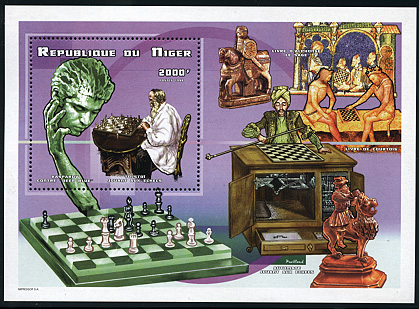
Kasparov v Deep Blue, Philadelphia, 1996
Reminiscent of Fischer's amazing perfect score in the 1963 U.S. Championship (Crosstable), GM Koneru Humpy currently has a perfect 8-0 score in the Women's National Championship of India.
I've found seven of her eight games. Enjoy.
Those of us who listened to the John Fedorowitz's commentary on www.chess.fm had prepared ourselves for a Kasparov loss yesterday. Kasparov had obtained an awkward King's Indian-type set-up in which the computer with white had meaningful chances to push the white queenside pawns. But the fact is that by move 31, the computer had lost any hope of a sustained initiative. Pawn exchanges on the queenside left Gary with the only hope of a win. He neatly defended his queen against the threat of a capture on e5 with 31...Kh7 and I expected that he would then proceed calmly to double his rooks on either the c- or g-file followed by h4 and either ...h3 or ...g3.
I think that was indeed the plan, but Gary, perhaps letting down for just a moment, blundered badly with 32...Rg7 rather than 32...Rg8. The result was a game-jarring capture on e5 with a forced resignation just a few moves later.
It probably doesn't matter to most folks. I attended one of the games in Kasparov's first match in Philadelphia in 1996. He lost badly in that game. I remember stopping at a Taco Bell on the way home. At the counter, I mentioned to the cashier that this was a dark-day for humanity... that the world chess champion had just lost to a computer. "Don't know about it," replied the clerk. "You want dessert?" It was then that I realized that while humanity had taken a beating, humanity really didn't care.
I wrote up the happenings that day in an article, "A Deep Blue Day," that appeared in my book, The Chess Analyst. Enjoy!
Gary Kasparov v Fritz again today. The broadcast will be live on ESPN2 starting at 1 pm. Perhaps with a win, Gary will make ESPN's top ten. Those 3D glasses should help. I expect a hedgehog formation... more on that in the weeks ahead here on the Chess BLOG.
NEWS FLASH: Fritz wins game 2.
 A quick update on me. I just received ICCF (International Correspondence Chess Federation) medals for winning the 8th North American Invitational Correspondence Championship... and for obtaining my SIM (Senior International Master) title. The picture here shows Max Zavanelli (representing the USA) receiving my SIM medal from ICCF President Josef Mrkvicka. Unfortunately for me, the award ceremony was in the Czech Republic.
A quick update on me. I just received ICCF (International Correspondence Chess Federation) medals for winning the 8th North American Invitational Correspondence Championship... and for obtaining my SIM (Senior International Master) title. The picture here shows Max Zavanelli (representing the USA) receiving my SIM medal from ICCF President Josef Mrkvicka. Unfortunately for me, the award ceremony was in the Czech Republic.
My Great Game Archive is now up to 1978, and I hope to add 1979 and 1980 games this weekend. The 1979 Montreal tournament was the highlight of that year. This so-called "Tournament of the Stars brought together Karpov, Spassky, Tal, Hubner, Larsen, Portisch, Hort, Timman, Ljubojevic and Kavalek. This was one of the strongest tournaments ever assembled, and it will long be remembered for the high quality of the chess and the wonderful tournament book authored by Mikhail Tal.
Here are all of the games from the event and here is the crosstable.
The book, which unfortunately is out of print, is a real treasure. Tal introduces every round and many of the games are deeply annotated. Karpov and Tal also offered interviews.
The highlight of 1980 was Kasparov's win in the World Junior Championship. There's no tournament book on that, so far as I know, but the games will be posted here soon.
Like so many folks yesterday, I really thought that Gary would prevail. He got a great position out of the opening with a new move, 11.0-0-0, and he soon won an exchange with 19.c6. I have to believe that the whole idea was carefully planned. He achieved a clear advantage in a position he would have won against probably any human on earth. But this bag of bolts isn't easily intimidated.
For those of you who are interested in the opening variation used in that game, here is a nice collection of similar games.
For the beginners among you, I will begin to share the three laws that I have used in my teaching. The first law must, of course, be the most important.
COACH's LAW #1: "When your opponent's king can't move, all you need is check."
I know, it sounds almost funny, but the fact is that this first law helps beginners to understand most mating combinations. Here are three quick examples. All are BLACK to move and win:
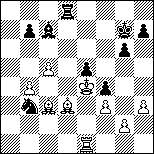
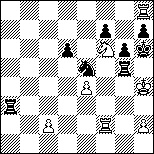
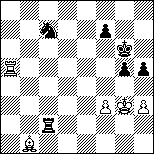
First, in honor of the start today of Kasparov's 3-D match against Fritz, I offer the games from his major matches against computers. I predict a narrow win for Gary... at least I hope so. Mankind needs some good news and the machines don't care.
NEWS FLASH: Here's the game... a draw ... but Gary missed a win!
About 7 years ago, I wrote a few electronic books for ChessBase. They didn't sell well in no small part because it was too easy to just copy and share them. Ah, the joys of electronic publishing.
I may not have made much money making The Hedgehog, ...d5 Pawn Breaks in the Sicilian, and Sacrifices in the Sicilian, but I sure learned a lot, not only about chess and publishing, but also about the features in ChessBase. The books made extensive use of the database's ability to place games in different thematic groups. So for example, in Sacrifices in the Sicilian, it was easily possible to view all the games that involve certain kinds of sacrifices.
I hope that sounds interesting, because here are two game collections that you may find interesting. This first collection contains nearly 700 games that involve the RxNh5 rook sacrifice in the Sicilian Dragon. When does it work? When does it fail? Play through these games and you will have an expert's experience in the Dragon!
The second collection presents about 300 games that involve black's RxNc3 sacrifice in the Sicilian Dragon. There are fewer games here because this theme was so common, I only placed here games in which both opponents had a rating of 2400 or more. That means that this smaller collection is leaner and meaner and well worth your attention.
My favorite books are "Zurich, 1953" and the 1960 Tal-Botvinnik match. But not far behind is Tal's autobiography "The Life and Games of Mikhail Tal". Tal, the great tactician, who defeated Botvinnik in 1960 only to lose the 1961 rematch.
One of the world's greatest-ever players, but ill-health continued to deprive him of chances to regain the championship throne.
Here are the 100 games from his autobiography. Even if you don't have the book by your side, this is a fantastic chess collection.
In 1970, William Cozins published a wonderful book, "The King Hunt in Chess." I have the Dover reprint published in 1975. It's a collection of 45 games (and I love thematic game collections) all with hunts of the king. Often sacrificial attacks that result in driving the enemy king into the open board.
In 1996, John Nunn reprinted the book (now titled "The King-Hunt") in algebraic notation with 10 additional games. The result is an improvment of this small classic and I recommend it. I have placed here all of the games from Cozens and Nunn's King Hunt. Enjoy!
I start today by sharing one of my most memorable games. This extraordinary game was played against a very strong correspondence master. Don't be bashful about counting the number of discovered checks in this game!
1.e4 e5 2.Bc4 Nf6 3.d3 c6 4.Nf3 d5 5.Bb3 Bb4+ 6.Bd2 Bd6 7.Nc3 d4 8.Ne2 0-0 9.h3 h6 10.c3 c5 11.g4 Nc6 12.Ng3 dxc3 13.bxc3 Be7 14.Qe2 Qd6 15.Rd1 Be6 16.Nf5 Bxf5 17.gxf5 Rad8 18.Bc1 Na5 19.Bc2 Nc6 20.0-0 Qc7 21.Kh1 Kh7 22.Rg1 Qa5 23.Bb1 c4 24.d4 Qxc3 25.Bb2 Qb4 26.dxe5 Rxd1 27.Rxd1 Nh5 28.f6 Bc5 29.Ng5+ Kg6 [29...hxg5 30.Qxh5+ Kg8 31.Qxg5 g6 32.Qh6; 29...Kg8 30.Qxh5 Qxb2 31.fxg7+-] 30.Nxf7 Bxf2 [30...Kxf7 31.Qxh5++-; 30...gxf6 31.Qg4++-] 31.Qxf2 Kxf7 [31...Rxf7 32.Qf5#] 32.fxg7+ Kxg7 33.e6+ Kg8 34.Rg1+ Kh7 35.e5+ Kh8 36.e7 [36.Qf7+- Rxf7 37.exf7 Qf8 38.e6+ c3 39.Bxc3+ Nd4 40.Bxd4+ Ng7 41.Rxg7 Qxg7 42.f8Q#] 36...Qxe7 37.e6+ Nf6 38.Qd2 There's no acceptable way to stop Qxh6 1-0
Here's an amazing combination from a 1914 speed game between the Cuban, Jose Capablanca and then World Champion Emanuel Lasker.
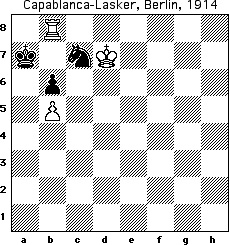
1.Ra8+ Nxa8 [1...Kxa8 2.Kxc7 Ka7 3.Kc6 Ka8 4.Kxb6 Kb8 5.Kc6 Kc8 (5...Ka7 6.b6+ Kb8 7.b7 Ka7 8.Kc7) 6.b6 Kb8 7.b7 Ka7 8.Kc7] 2.Kc8 Nc7 Black's only legal move! 3.Kxc7 Ka8 4.Kxb6 Kb8 5.Kc6 Kc8 6.b6 Kb8 7.b7 Ka7 8.Kc7 *
For a while, I've pondered how best to add a new facility to this web site... permitting folks, especially beginners, to play each other. There are other places to play. Yahoo is one of the most obvious places. Of course there's the Internet Chess Server and the Free Internet Chess Server. And there's chessanytime.com and I'm sure many many more.
But I imagine a place where beginners and intermediate players can come to play and to learn. Support, for example, for those who need some help with how the pieces move.
I explored a few possibilities, but it occurs to me that someone out there may have a solution. If you do, please please get in touch. I have enough server space to keep something cool going. And I'm open to all sorts of possibilities, though the goal should be to serve young and new players to the game. Thanks for listening
I received an e-mail yesterday from a Chess is Fun visitor, who wondered why Spassky resigned to Fischer in the final game 21 of their 1972 match. After all, a resignation would mean that Fischer would take the title. As I said just yesterday, finding out why a grandmaster resigned can sometimes be a great challenge. They see the reason, but can we?
I encourage you to play through that 21st game. You will certainly gain an appreciation of the depth that these great players see, and the complexities that they appear to understand almost trivially.
1.e4 c5 2.Nf3 e6 3.d4 cxd4 4.Nxd4 a6 5.Nc3 Nc6 6.Be3 Nf6 7.Bd3 d5 8.exd5 exd5 9.0-0 Bd6 10.Nxc6 bxc6 11.Bd4 0-0 12.Qf3 Be6 13.Rfe1 c5 14.Bxf6 Qxf6 15.Qxf6 gxf6 16.Rad1 Rfd8 17.Be2 Rab8 18.b3 c4 19.Nxd5 Bxd5 20.Rxd5 Bxh2+ 21.Kxh2 Rxd5 22.Bxc4 Rd2 23.Bxa6 Rxc2 24.Re2 Rxe2 25.Bxe2 Rd8 26.a4 Rd2 27.Bc4 Ra2 28.Kg3 Kf8 29.Kf3 Ke7 30.g4 f5 31.gxf5 f6 32.Bg8 h6 33.Kg3 Kd6 34.Kf3 Ra1 35.Kg2 Ke5 36.Be6 Kf4 37.Bd7 Rb1 38.Be6 Rb2 39.Bc4 Ra2 40.Be6 h5 41.Bd7 The game was adjourned at this point, with Spassky sealing 41.Bd7. Spassky resigned because he quickly saw that, even with the best defense, he is lost. [41.Bd7 Kg4 42.b4 h4 43.a5 h3+ 44.Kg1 Ra1+ 45.Kh2 Rf1 46.a6 Rxf2+ 47.Kg1 Kg3 48.Bb5 h2+ 49.Kh1 Rg2 50.a7 Rg1#; 41.Kh3 the correct move, to stop ...Kg4 41...Rxf2 but Byrne and Nei point out the correct path even had Spassky played the best defense 42.a5 (42.Kh4 Rh2#) 42...h4 43.a6 Kg5 44.Bd5 (44.b4 Rf3+ 45.Kg2 Kg4 46.a7 (46.b5 Ra3 47.Bc8 Ra2+ 48.Kg1 Kg3 49.b6 Ra1#) 46...Ra3) 44...Ra2 45.Bb7 Ra3 46.Kg2 Kxf5 47.b4 Kg4 48.b5 h3+ 49.Kf2 h2 50.b6 Rxa6 51.Bxa6 h1Q] 0-1
Here are all the games from that wonder Fischer - Spassky match in 1972. It was an amazing achievement for Fischer. Don't miss games 6 and 13. Crosstable
A new book on the 1972 has also appeared. A translation I gather from the Dutch. Two grandmasters Max Euwe and Jan Timman offer: Fischer World Champion!: Finally Available in English - The Acclaimed Classic About the 1972 Fischer-Spassky World Championship Match
One of the nice things about owning a chess database is its entertainment value. Just open up the search mask (Alt-M in ChessBase) and search for quick wins by great players. Here's a small 20 game database I assembled in just a few minutes: quick (under 20 move) wins (and losses!) by Garry Kasparov. There are some nice games here, including a famous loss in a Caro Kann to Deep Blue.
One of the challenges... see if you can figure out why someone resigned! When I just starting out, the first challenge was just setting up the board and playing through the game correctly. Here, you can tap your way through. But why did they resign? Give it a shot.
Kasparov's quick wins (and losses)
 Today, I purchased Secrets of Positional Chess (How to exploit strengths and weaknesses on the chessboard) by Drazon Marovic. I'm always looking for examples for my weekend chess teaching. Here's an example from the book:
Today, I purchased Secrets of Positional Chess (How to exploit strengths and weaknesses on the chessboard) by Drazon Marovic. I'm always looking for examples for my weekend chess teaching. Here's an example from the book:
1.e4 c5 2.Nf3 e6 3.d4 cxd4 4.Nxd4 Nf6 5.Nc3 d6 6.Be2 Be7 7.0-0 0-0 8.Be3 Nc6 9.f4 Qc7 10.Qe1 Nxd4 11.Bxd4 e5 12.Be3 Be6!? [12...exf4 first and then ...Be6] 13.f5 Bc4 14.Bxc4 Qxc4 15.Bg5! I usually develop my Bc8 to b7 in such lines where it exerts useful pressure against the white e4-pawn. Here, black has exchanged the light-squared bishops, so white plays Bg5 to capture the Nf6 opening up the d5-square. 15...Rfe8 16.Bxf6 Bxf6 17.Nd5 knight to the middle of the board where the enemy pawns cannot attack it. And now ...Qxc2 Rc1 with Nc7 to follow. 17...Bd8 18.c3 b5 19.b3 Qc5+ 20.Kh1 Rc8 21.Rf3 Black has no meaningful chances on the queenside, and the black kingside is open to the assault. 21...Kh8 [21...f6] 22.f6! gxf6 23.Qh4 Rg8 24.Nxf6 Rg7 25.Rg3 Bxf6 26.Qxf6 Rcg8 27.Rd1 d5 28.Rxg7 Marovic writes: "Impressive in its simplicity, this victory was built on the basis of a single strong square. Its fruit was the centralized knight, which helped to transform white's spatial preponderance into the final assault." *
Please feel free to sign the new Chess is Fun Guestbook. Or try the Chess is Fun Chat!
since November 6, 2003
How to support this web site? There are expenses for storage and the domain name. If you enjoy this site and want it to grow, please consider making your chess purchases by starting at this site. We get a small commission from Amazon and the other vendors with each purchase, so long as you go to Amazon or those vendors from here... even if it's not one of our listed products! Thanks for your support!
Or, if you prefer, you can make a small, voluntary donation via Paypal:
Copyright, Jon Edwards 2003
All rights reserved